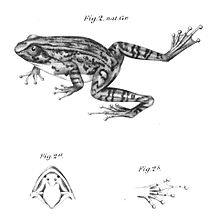| Petropedetes cameronensis | |
|---|---|

| |
| Illustration that accompanied the original species description of Petropedetes cameronensis. | |
| Conservation status | |
 Least Concern (IUCN 3.1) | |
| Scientific classification | |
| Domain: | Eukaryota |
| Kingdom: | Animalia |
| Phylum: | Chordata |
| Class: | Amphibia |
| Order: | Anura |
| Family: | Petropedetidae |
| Genus: | Petropedetes |
| Species: | P. cameronensis |
| Binomial name | |
| Petropedetes cameronensis Reichenow, 1874 | |
| Synonyms | |
|
Petropedetes obscurus Ahl, 1924 | |
Petropedetes cameronensis, sometimes known as the Cameroon water frog, is a species of frog in the family Petropedetidae. It is found in southeastern Nigeria, southwestern Cameroon, and on the island of Bioko (Equatorial Guinea). It is the type species of the genus Petropedetes.
Description
Petropedetes cameronensis is a small-sized Petropedetes with compact body. Males measure 27–35 mm (1.1–1.4 in) and females 34–49 mm (1.3–1.9 in) in snout–vent length. The snout is short. The tympanum is very small and rather indistinct, and without tympanic papilla (present in breeding males of many other Petropedetes species). The iris is golden. The canthus rostralis is sharp. The dorsum is light or dark brown with pale spots. Dorsal skin structure is variable with larger warts on the flanks and few large, longitudinal warts on back. The toes are approximately half-webbed.
The male advertisement call is a whistle or a trill that drowns the noise of flowing water.
The tadpole has a muscular tail that enables it to jump on stones; the tail is long and has no ventral fin and only a very narrow dorsal fin.
Habitat and conservation
Petropedetes cameronensis lives near and in flowing water, for example on stones in a fast-flowing stream and in rapids and waterfalls. It generally occurs at low altitudes but sometimes as high as 1,400 m (4,600 ft) above sea level. The eggs are laid on tree trunks or leaves close to humid rocks. The tadpoles are saxicolous (living on rocks).
Petropedetes cameronensis is a fairly common species, but it is threatened by habitat loss caused by agricultural development, logging, and growing human settlements. It is found in the Korup National Park (Cameroon).
References
- ^ IUCN SSC Amphibian Specialist Group (2017). "Petropedetes cameronensis". IUCN Red List of Threatened Species. 2017: e.T58078A49316865. doi:10.2305/IUCN.UK.2017-2.RLTS.T58078A49316865.en. Retrieved 16 November 2021.
- ^ Frost, Darrel R. (2016). "Petropedetes cameronensis Reichenow, 1874". Amphibian Species of the World: an Online Reference. Version 6.0. American Museum of Natural History. Archived from the original on 17 November 2016. Retrieved 16 November 2016.
- "Petropedetes cameronensis Reichenow, 1874". African Amphibians. Archived from the original on 17 November 2016. Retrieved 16 November 2016.
- "Petropedetes cameronensis". AmphibiaWeb: Information on amphibian biology and conservation. . Berkeley, California: AmphibiaWeb. 2008. Retrieved 16 November 2016.
- ^ Barej, Michael F.; Roedel, Mark-Oliver; Gonwouo, N. L.; Pauwels, Olivier SG; Boehme, Wolfgang; Schmitz, Andreas (2010). "Review of the genus Petropedetes Reichenow, 1874 in Central Africa with the description of three new species (Amphibia: Anura: Petropedetidae)". Zootaxa. 2340: 1–49. doi:10.11646/zootaxa.2340.1.1.
| Taxon identifiers | |
|---|---|
| Petropedetes cameronensis | |